Dear Artist,
Ellen Winner, Professor Emerita of Psychology at Boston College and Senior Research Associate at Project Zero, Harvard Graduate School of Education, studies learning, thinking and creativity in the arts. As part of her role as founder and director of the Arts and Mind Lab at Boston College, Dr. Winner studies how we look at art, what art does to us and how we determine what art is. Essentially, she works at the center of our cognition of the term, “art.” Dr. Winner suggests rather than asking if something is art, we should, instead, be asking when something is art.
As part of her studies, Dr. Winner tested people’s ability to distinguish between abstract paintings made by artists and those made by preschoolers and animals. Her team paired 30 works made by masters including Hans Hofmann and Willem de Kooning with the daubs and swooshes of young children, elephants and chimpanzees. Each pair of paintings was similar in palette and brushwork. Participants were asked to choose which in each pair was better, which they liked more and which was done by an artist rather than an animal or child. Sometimes, the works were shown one at a time instead of side by side, and other times the researchers fastened misleading labels, to see if the participants could be tricked.
In each experiment, Dr. Winner’s team discovered that people unschooled in abstract art preferred the artists’ works, and they did it at a rate significantly above chance. These unlikely and sudden modern art buffs were also totally unfazed by the mislabelling. Add to this that the team then turned the paintings over to a computer learning algorithm, which differentiated in no time the works done by artists — at the same rate of accuracy as the human participants.
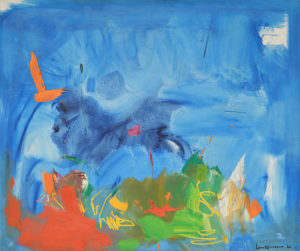
Such is the Way to the Stars (Sic Itur Ad Astra), 1962
Oil on canvas
60 1/8 × 72 1/8 inches
by Hans Hofmann
Sincerely,
Sara
P.S: “It is the spectators who make the pictures.” (Marcel Duchamp)
Esoterica: Next, Dr. Winner and her team showed a group of new participants the 60 paintings in succession, but asked only which works looked intentional and which had the most structure. The works by artists consistently won. The team arrived upon a clear discrimination: marks made by preschoolers and animals appear random. This is supported by the finding that random-looking stuff by human artists scores low on the structured and intentionality scale too, and is thusly mis-identified as the work of children or animals. Dr. Winner’s conclusion is that people can see, or perhaps even sense, with what she calls “aesthetic intuition,” an artist’s mind and intentions — her plans. Another word for this, perhaps, is imagination. It explains, in part, what’s going on when we look at non-objective works of creativity, like abstracts. “People see,” says Dr. Winner, “more in abstract art than they think they see.”
“Anything can be treated as art or not. And when we treat something as art, we attend to it in a special way — for example, noting its surface formal features and its nonliteral expressive features as part of the many meanings of the work. Maybe we can’t define art, but we can specify what it means to adopt an aesthetic attitude. And while elephants and chimps may make “art,” and while birds may make “music,” I am confident that humans are the only creatures who step back from something they are making to decide how it looks or sounds and how it should be altered — in short, to adopt that aesthetic attitude.” (Ellen Winner)
Ellen Winner’s 2018 book, How Art Works: A Psychological Exploration is available, here.
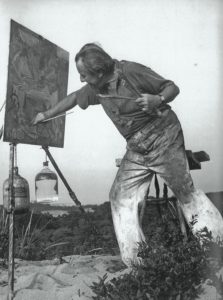
Hans Hofmann painting in the dunes near his summer home in Provincetown, MA, 1942.
Herbert Matter photo.
“A thing in itself never expresses anything. It is the relation between things that gives meaning to them and that formulates a thought. A thought functions only as a fragmentary part in the formulation of an idea.” (Hans Hofmann)
Have you considered a Premium Artist Listing? With each letter, an artist is featured at the bottom of this page. The Premium Artist Listings are a means of connecting artist subscribers through their work. Proceeds from each listing contribute to the production of The Painter’s Keys.
“Art’s whatever you choose to frame.” (Fleur Adcock)
Featured Workshop
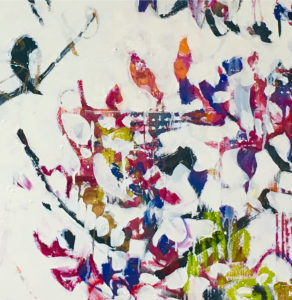 Join Ellie Harold for “Intuitive Painting: Permission to Paint Expressively,” designed especially for mature women artists of all skill levels who wish to explore this medium for soulful exploration. The retreat provides attractive accommodations (your own room!) along with lightly structured activities for centering, relaxation and low stress art-making. You’ll have plenty of free time to muse, paint, write and reflect while enjoying the colors, textures and flavors of San Miguel. This Retreat has the potential to transform not only your art but your life! You’ll return home with a specific art “care plan” to assure support for further creating. Details at www.EllieHarold.com.
Join Ellie Harold for “Intuitive Painting: Permission to Paint Expressively,” designed especially for mature women artists of all skill levels who wish to explore this medium for soulful exploration. The retreat provides attractive accommodations (your own room!) along with lightly structured activities for centering, relaxation and low stress art-making. You’ll have plenty of free time to muse, paint, write and reflect while enjoying the colors, textures and flavors of San Miguel. This Retreat has the potential to transform not only your art but your life! You’ll return home with a specific art “care plan” to assure support for further creating. Details at www.EllieHarold.com.
Featured Artist
My aim as a painter is to bring to life a slice of the world as I experience it. Light, color and form are my vocabulary.

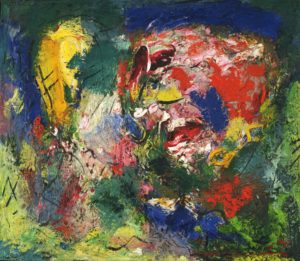

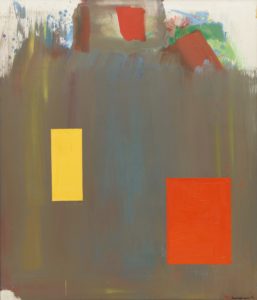




23 Comments
I expected you to show a few pieces painted by children. Art by children is ‘pure’ & cannot be critiqued because intention & design is not involved. We ought to pay more attention to the artistic expressions of the
Innocents.
AMM, I think the point of the article is, in abstract art, deliberateness not only exists but is detectable to most people.
Children’s art is not the same as abstract or even naive art. Children are experimenting and learning, and sometimes they achieve aesthetic balance, design, and colour usage, and often they won’t. Which is perfectly where they should be, and what they should be doing.
It still isn’t deliberate or being done with conscious, mastered techniques. I am glad someone studied it and helped to lay to rest that a whole, “What do you mean it’s worth a million dollars?!
I, (or my kid, or my dog), could of done that!”
Well said, I get so upset when I hear that comment………I could have painted that.
I totally agree with you. Nobody does this with any skill other than art.
I once entered a fence painting contest. We were giving a large sheet of mdf and a selection of paints. My 4-year old did a painting beside me on one of these sheets.. I did nothing more than supplying her with paint. Her painting won the under 13yr old division. While it was abstract, it looked to me like a red rooster perched on a fence with a flower bed in the foreground. As one famous artist said -I paint what I want people to see, not what I see.
I agree with the comment from AMM and was disappointed you didn’t show work from the children. Abstract work and postmodernism in general tend to stifle the viewer and continue with the overall dumbing down of society. Artspeak dedicated to proclaim the value in abstract art is always contrived to make something of it that is not apparent in the work itself. I believe the innocents use greater imagination in their processes to produce art, something that is lacking in the abundance of splatter and meaningless brushstrokes we find in abstract art. I also find the final quote “Art’s whatever you choose to frame” a very telling comment especially when referring to abstract work. Art has become an entertainment medium furthering sensationalism and creating celebrities who have little value except to the auction houses and the curators that promote them. A return to regionalism with the emphasis on representative work would help to turn things around and perhaps even save the world if not change it in a more desirable direction. Art should deliver a message to the public for them to decipher with the hope it comments on the environment both in society and culture.
Abstract art is NOT just splatter and meaningless brushstrokes. It is sad to me when other artists can’t see the skill and meaning and intent and feeling in abstract work. Some of the most beautiful works I have ever seen are abstracts. They are wonderful because you see the beauty of the forms, composition, colours, brushstrokes and application of paint by itself. You are not distracted by the subject matter. You can appreciate all of the nuances of the paint.
(However, I agree that some of the art promoted by auction houses seems to have other factors involved than the quality of the work.)
I realize I’m a nobody with minimum experience in abstract work, but Mr. Hofmann’s work looks random to me. I wouldn’t credit it with intentional marks.
I think it looks like stuff they pulled from his dumpster….
I have gratefully dedicated my life to creating fine art. I believe one’s ability to see, imagine, explore, experiment, and replicate, involves time, will and loads of patience. As we know, the simplification of marks by children and animals can often offer beauty and spontaneity, without the stigma of being overworked and over thought. The outcome of the study mentioned isn’t surprising to me. One reality is that ultimately it’s in “the eyes of the beholders” of those who are chosen as judges and critics for acceptance of most work placed into art exhibitions, museums and competitions.
Picasso worked in his chosen style at various periods in his lifetime, realistically and abstract. I often wonder if his unique variety of styles would be ridiculed or widely accepted by judges if he exhibited today!
there must be somthong wrong with me, I can not see any talent in the paintings ,any child can do better than that
Children paint, elephants paint but I d oubt if they begin with what if or I wonder.
Thanks, Sara. I think her findings are really interesting and give hope to those of us who create abstract pieces that there might be a larger population of people who understand (or intuit) what we’re doing, than we might otherwise think!
“Such is the way to the Stars” gives me a perfect image reminder that we are all free to break off from our stories of limitation and allow ourselves to go to the stars of all potential. Time for me to start studying Hofmann. I love your letters.
I would have liked to see the work of the children and animals that were compared to the humans’ art. I was also waiting to read about comparison’s made by schooled people as well. In the same vein, to be fair, comparisons should have included works by untrained/beginner artists. Comparing works from experienced artists to the most rudimentary of innocents is extremely biased. From the content of this article at least, it seems this study was designed to prove a point rather than to adhere to proper scientific data collection and analysis.
I agree with you , Evelyn K. I think that children have the ability to create an abstract piece of art as good as any formally-trained grownup artist. They just don’t do it as often. I also think that a grownup artist is just as likely to create something that looks as random as a child’s art. Hopefully, because of their training, they do it less often.
If you are a parent or a friend of children, you have probably seen a lot of children’s art. My daughter painted hundreds of. Pictures, some that were wonderful and hit the mark enough to frame and hang on the wall. Maybe one out of a hundred. And I love looking at them and they make me smile. But when I look at paintings by Joan Mitchell, they consistently take my breath away. I’ve never had that response to a painting by a child or an elephant, though I enjoy looking at them. Abstract and realism follow the same rules.
Well said!
Love the discussion! Thank you Sara.
Yes, a lovely discussion, Karen. One of the joys of Painters Keys is the wide range of thoughts, experiences, views, ideas and so on from readers. Today’s art is a crazy mixed-up world but it always has been; only in retrospect does it make sense. A bit like life itself.
One thing we can all agree on is that Sara and Robert’s letters are beacons of sanity in all the (apparent) madness.
As an artist for over fifty years I object to categorizing art that doesn’t show you an identifiable subject as an “abstract”. Abstraction in painting is not the opposite of realism but rather the expressive attempt to focus more specifically on some aspect or aspects of the process of painting in a new way. The elements of art are still the same regardless of the artistic result. These basic elements may incorporate all or some of the following: Line, Shape, Mass, Space, Color, Tone, Texture, Pattern, Contrast, Repetition and Composition.
Within these there are variations as well. Taking Color for example you may note effects of Value, Intensity, Temperature, Color Schemes. etc. These are the basic tools of any artist whether you are looking at the work of Rembrandt, Monet, Picasso, or DeKooning. It is the imagination of the artist and the challenges of the interior or exterior world he lives in, that validates the final result as ART!
Dear Sara, I love reading your articles and love reading the discussions and very very often I totally agree with your or your father’s point. You often offer me a very good insight and you give solutions to most of our typical artistic “problems” or issues. On this topic however I have a few things to say. I am currently translating into Dutch the fantastic book by your great American scholar, Michelle Marder Kamhi, “Who Says That’s Art?” She did so much research about quite recent art history that most people forgot. She offers great insight into what art is and was and has been all over the world. She offers insight concerning the origins and history of most “- isms” from the 20th century. On p 144 and 145 of that book she mentions the study by Ellen Winner from project Zero. Apparently “in 35-40% of the cases they observed, work by the world’s abstract leaders painters was not distinguished from the products of animals and children.” This seems a very high percentage! With Michelle Kamhi, I am asking: Would any figure nearly that high have resulted if the comparison had been between traditional representational works by accomplished artists and images made by young children?
As someone said, this project zero study was clearly done to prove a point…
To John Maurer and Evelyn Kirkaldy : I agree with you!
To Zidonja: “no, I don’t think there is anything wrong with you…!”